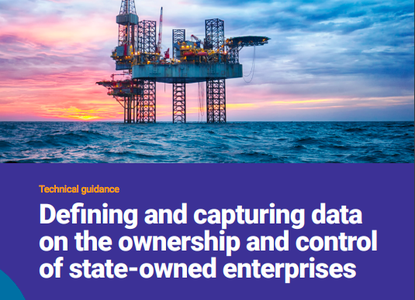State-owned enterprises and beneficial ownership disclosures

State-owned enterprises (SOEs) are a critical part of the global economy with unique potential to shape and drive economic growth.
Because SOEs are effectively stewarded for the benefit of the public, understanding how they are owned and controlled is complicated. However, their size and growing economic importance makes SOE transparency and accountability vital.
Improving the ownership transparency of SOEs as part of beneficial ownership disclosures will therefore help ensure that their role is better understood and will help meet beneficial ownership transparency‘s aims of increasing accountability, improving the business environment, and safeguarding national security interests.
What is Open Ownership doing?
Open Ownership (OO) is, firstly, making recommendations on what information to collect on state ownership and control, and, secondly, updating the Beneficial Ownership Data Standard (BODS) in line with this advice.
Why?
An SOE is defined by the Organisation for Economic Co-operation and Development (OECD) as being “under the control of the state, either by the state being the ultimate beneficiary owner of the majority of voting shares or otherwise exercising an equivalent degree of control”. SOEs are a major contributor to the economy. Standardising the beneficial ownership declarations produced by such organisations will allow state ownership and relevant individuals to be clearly identified, feeding into improved monitoring, governance, and performance of SOEs.
State ownership or control is not just about entities that meet the formal definition of an SOE. A state can be a minority owner and still exercise significant influence and control over a company. States can exert extraordinary types of formal control in multiple ways, for instance, through ownership of a so-called “golden share”; using their financial resources to provide direct or indirect support; implicitly backing companies (which feeds into assessments of credit risk); and exerting informal influence that affects firms’ behaviours in ways that are relevant to investors, competitors, and citizens. In some policy contexts, like national security or countering nuclear proliferation, it may be necessary to detect any level of state ownership or control as well as links to known state entities.
Knowing which state owns or controls a company is only half the picture. The state body, agency, or office through which the state exercises control is equally important. For example, in China, the State-owned Assets Supervision and Administration Commission of the State Council (SASAC) manages SOEs on behalf of the Chinese state, and is declared as the Person of Significant Control (PSC) for many companies on the UK’s beneficial ownership register. Information on state bodies is more diverse than information on companies, so standardising how this is collected and published will improve usability.
SOEs may not have individuals who meet relevant legal definitions of a beneficial owner, but understanding the interests and involvement of natural persons is still likely to be important for improving the governance and integrity of SOEs. A beneficial ownership register may not only be useful for recording some of this information, but it can also act as a bridge to other sources of information, such as a list of directors on a company register or a company’s own transparency disclosures.
What Open Ownership recommends
1. Require companies to declare ownership and control by states
At present, laws and regulations on beneficial ownership disclosure may not cover, or may be ambiguous about, declaring state ownership. A lack of systematic disclosure policies leads to uncertainty about the completeness of the data, lower quality disclosures, and high barriers to data use and engagement.
This can be solved with an explicit, legal requirement for SOEs to disclose ownership and control to central beneficial ownership registers. The exact method of disclosure will depend on local context but can draw on the Open Ownership Principles and the detailed design considerations outlined below.
2. Ensure that disclosure frameworks account for the complexity of state ownership and control
The differences between ownership and control by states and ownership and control by natural persons should be considered when designing a disclosure framework:
- It must always be possible to link a declarable state ownership or control interest to the state that controls it, and this link should be explicit rather than inferred. For example, an interest should be declared as controlled by “The Department for Education” with a jurisdiction of the “United Kingdom” to disambiguate from similarly named departments in other countries.
- A disclosure framework should associate a declarable interest with a state body, agency, or office in addition to a jurisdiction. For example, “The Department for Education” with a jurisdiction of the “United Kingdom” would be better than just a jurisdiction of the “United Kingdom”.
- A disclosure framework for state interests may define a declarable state ownership or control interest by using the same thresholds as would apply to a natural person and calculating aggregate interests in the same way. For example, if a natural person was required to declare a beneficial interest at a 10% threshold, then a combined state ownership or control interest of 12% would be declarable even if this was owned and managed by two separate state bodies with individual holdings under the threshold, e.g. 7% and 5%. In other regulatory contexts (like national security), a lower or zero threshold may be needed.
- The scope of disclosure should be clearly defined, including the need to disclose a full ownership chain and, in the case of state ownership, where the ownership chain terminates. Full visibility of state ownership may suggest, for example, a state-owned oil firm disclosing its ownership by a state asset management company, ultimately controlled by a finance ministry. A more practical approach, however, may be to terminate the chain of ownership at the first state body. OO’s beneficial ownership disclosure workbook can be used to work through the approach a disclosure framework will take.
- A disclosure framework should specify the circumstances under which natural persons are considered to have declarable interests associated with state ownership or control. As set out in OO’s definitions briefing, senior management or board members should be considered to have declarable interests if they have rights or powers that fall under the local definition of beneficial ownership. In the expected absence of a beneficial owner, it may be desirable to require the disclosure of a natural person with responsibility for the company’s disclosures. Other systems may be more suitable for broader disclosures of natural persons, for example, defining certain members of senior management as politically exposed persons (PEPs) by virtue of their role in an SOE, and instead declaring this status through a PEP or asset and interest register.
- A disclosure framework should enable all significant forms of state ownership and control to be declared and differentiated from non-state ownership where necessary. For the most part, states exert control over companies in ways that will be captured by a comprehensive legal definition of beneficial ownership. However, a robust definition should also cover extraordinary forms of control exerted through, for example, a company’s rules or articles, or through the ownership of a “golden share”. These mechanisms can give a government body or other entity control that outweighs ownership or voting rights. In addition, domestic forms of control related to state ownership should be considered and classified if these are sufficiently different from the forms of ownership and control exercised by private companies and individuals. It should be possible, for example, to distinguish an individual who is the beneficial owner of shares in an SOE from an individual who holds them in a trustee role on behalf of a state or state body.
3. Standardise the collection of information about states, state bodies, and natural persons
OO’s analysis of information on state ownership in existing beneficial ownership disclosures indicates serious data quality issues. These include: states and state bodies being described by name only; consistency issues created by minor variations to names, addresses, or other fields; and state bodies that cannot be linked to a particular jurisdiction.
A full understanding of state ownership and control requires clear regulations and guidance on disclosure requirements as well as standardised data collection practices. Clarity is important, as state ownership and control can be complex: a single jurisdiction may exert ownership and control through numerous bodies with a variety of legal forms, operating at different administrative levels. Data users therefore need to know both what to look for and how that information might have been declared in a beneficial ownership register.
In order to resolve these issues, a disclosure framework should require the following information to be collected on state bodies:
- The legal name for the state body. To ensure consistency, this name may come from a local list or register of state bodies, if this exists. However, names should not be solely relied upon for disambiguation, and consideration should be given to translation and transliteration issues.
- The jurisdiction for the state body from a recognised codelist.
- One or more unique, unambiguous, and permanent identifiers for the state body. These could include:
- a company number and registry identifier if the state body is a registered company;
- an identifier taken from a controlled list of government bodies (such as those collected at org-id.guide) and a registry identifier for that list;
- an identifier issued and managed by the central beneficial ownership register. A state body should be able to reuse this identifier across declarations made by different companies;
- an identifier issued and managed by a third-party, such as the Legal Entity Identifier (LEI). This may be a particularly useful identifier for state bodies that are not registered companies and for non-domestic entities declared as owners in a register. Guidance is available on the eligibility of government entities for an LEI, and there is growing support for their use in government.
- In choosing between these identifier options, consideration should be given to interoperability, sustainability, and any dependencies that will be created.
- In the absence of identifiers, further identifying information may be collected. For example, government bodies established by statute or another instrument could be identified by the name and date of the relevant statute.
For natural persons with declarable interests, a disclosure framework should require the following information to be collected:
- full name, date of birth and contact details;
- any relevant identifiers used in the register and that are necessary to facilitate connections with other datasets;
- the nature of ownership or control exercised by that person.
In collecting and publishing data on natural persons, consideration should be given to the principles of data minimisation, layered access, and implementing a protection regime.
In partnership with Open Data Services, OO is working to update the Beneficial Ownership Data Standard (BODS) in line with this advice. If you are looking to implement the BODS or would like additional support, please contact OO via our helpdesk or by email at [email protected].

